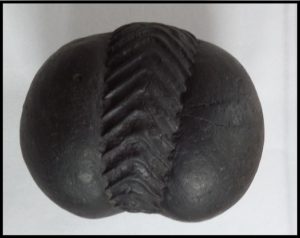I was recently asked (and not for the first time), what I do with all the Shaligrams I accumulate over the course of my research. It’s a great question, and I think, a particularly important one because it speaks to concerns many pilgrims and devotees have about how these sacred stones are treated in the hands of someone (meaning me) who may not necessarily use them for their more ubiquitous ritual purposes. Additionally, I am often in possession of quite a fair number of Shaligrams, many of which have been collected directly from Kali-Gandaki River, where the bulk of my research takes place.
In the interests of the ethical practice of anthropology, the majority of these Shaligrams are given away. In many cases, the Shaligrams I collect in Mustang are gifted to pilgrims I encounter during my travels, especially if I have a Shaligram specific to their needs or desires (for example, a Mahavishnu Shaligram the person in question has been looking for but unable to find). In other cases, I am able to answer direct requests from Vaishnavas in the United States who are otherwise unable to undertake Shaligram pilgrimage (though I am not able to do this very often). In just a few days however, I will be able to send a group of Shaligrams I collected in June to a new temple being built in the UK.
I am especially pleased that I am able to do this because it provides opportunities not only to experience a wide variety of the Shaligrams themselves (without also needing to accept the substantial responsibilities of caring for so many stones) but also to follow the stones outwards and meet the people most involved in Shaligram practice. In that way, I am not just a researcher of Shaligrams but I am also a direct participant in their mobility. And for those of you who have been following along for awhile, this theme of mobility will have special resonance.
Lastly, this is not to say that I do not have any Shaligrams at all myself. I have decided, once again in the interests of research, to keep one in particular that I have developed a rather special fondness for. This Lakshmi-Narayan Shaligram (pictured below) came to me as part of a group of Shaligrams I was bringing to a Vaishnava specialist in Kathmandu for identification. The rest of the group have since gone on to better practitioners, but this one was so unusual and so striking to my eye that I decided to keep it and, under certain circumstances, use it for teaching and demonstrations. Today, it lives in a small puja mandir in my office at home in Boston and, should I ever bring it out to the benefit of my students and colleagues, I am careful to observe the necessary ritual hand-washing procedures (I do not allow others attending the class or presentation to touch it), abstain from meat prior to handling, and ensure that the Shaligram never comes into contact with the floor, feet, or mouths.
It has been a privilege to conduct this work and I look forward to a great many more wonderful experiences in the world of Shaligram. As such, it is equally important that I continue to regard the objects of my inquiry with the respect they are due. This is true for the humans in question, just as much as it is for the Shaligrams.

Lakshmi-Narayan Shaligram at home in Boston
